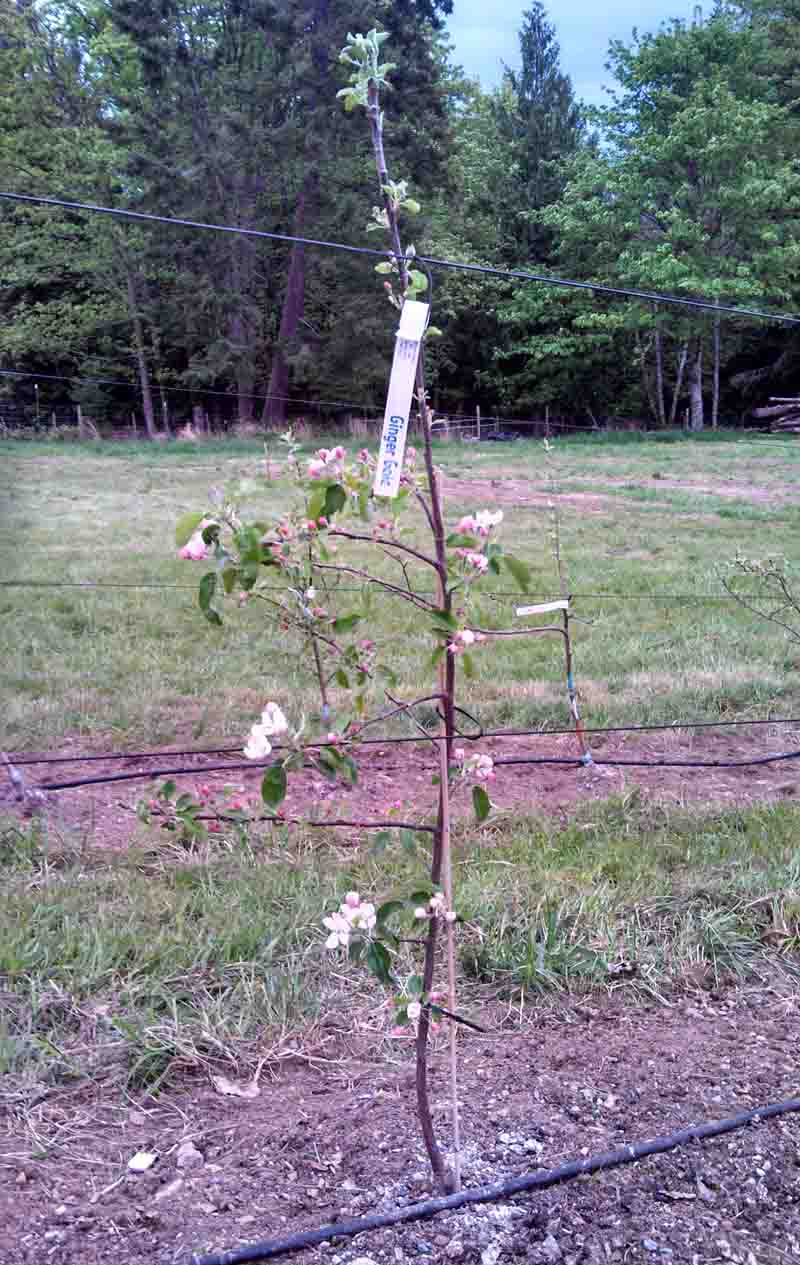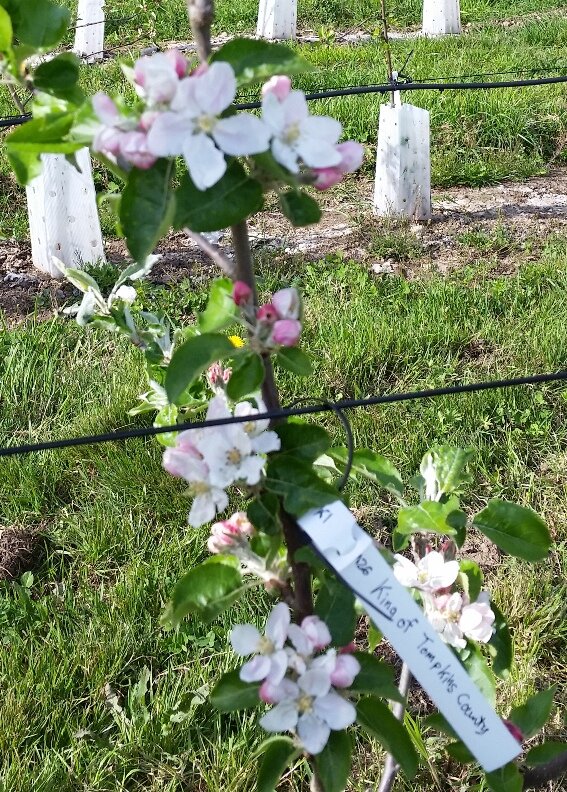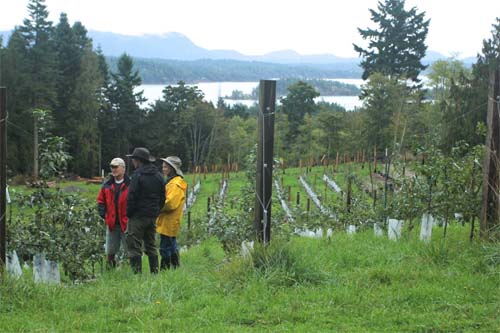One of Canada's Most Diverse Apple Orchards
First we chose great heritage apple varieties with a century-plus track record here on Salt Spring Island. Then we added modern, naturally disease-resistant varieties that never quite caught on, despite their great qualities. Then quirky varieties from around the world that make it easy to see how the apple really is Earth's greatest fruit. We sought out traditional cider varieties that may be virtually inedible fresh, but sure add character as part of craft cider. And then we added more of each. And more. And more.
After seven years of this, we surpassed 365 varieties in our orchard: truly an apple a day. And now beyond 460. Yes, it's our obsession.
We like to do our research first, then jump in with both feet and learn from experience. Here's what we're up to.
We sell certified organic young heritage and connoisseur apple trees in pots to folks on Canada's west coast.
We're growing more than 460 varieties of apples. Seriously. That many. And each of them is unique. Check 'em out.
Apple Tree Care
Planting Your New Apple Tree
We’ve got a few suggestions on how to keep your young apple tree healthy and happy.
Planting your own apple tree is super-easy and we’ve got some tips to make it even easier.
Certified Organic Apple Trees For Sale
We've got certified organic heritage and connoisseur apple trees for sale! Potted one year whips (trees grafted last spring) of many varieties are now available for $45 each, plus GST. We offer discounts for larger orders starting at 20 trees. You can also place an order for custom grafting, which we do in March of each year, for delivery in the following fall.
We have more than 460 different heritage and connoisseur varieties of apple trees. The varieties we have available at any one time vary, depending on what we graft and how quickly each variety sells.
Please come and visit us on beautiful Salt Spring Island to select your new apple tree. If that doesn't work for you, we may be able to deliver your new tree right to your door if you're located on Vancouver Island or B.C.'s Lower Mainland and, in March of each year, we can mail bareroot trees to other locations in Canada.
For gift-giving, you may want to consider buying a Salt Spring Apple Company gift card, which can be used on trees, cider or anything else we sell.
Please note that export requirements and quarantine rules stop us from shipping outside of Canada or to the Okanagan Valley. We are NOT able to ship to the United States. Sorry about that.
Check Out Our Current Inventory
Send us a Note About Buying a Tree
PLEASE NOTE: WE CAN ONLY SHIP WITHIN CANADA
How We Grow 'em
We've got Salt Spring Island's only high density organic apple orchard, growing about 1,200 trees per acre -- 3,560 in total -- using the 'tall spindle' method of training our trees.
We’re inspired and motivated by Salt Spring’s beauty and agricultural advantages, its history as western Canada’s one-time primary supplier of apples and the renaissance of apple growing that’s underway on the island.
We planted our first 360 dwarf trees in late 2011 and continued planting annually until we were fully planted in early 2016. Since then, we've been replacing dead, damaged and sickly trees and finding ways to cram a few extra into our orchard here and there.
When it’s in full production, we expect to harvest something more than 25,000 kilograms of apples each year.
We Don't Just Say We're Organic - We're Certified
We grow organically because it’s good for our health and yours. It’s also good for our natural environment. Going organic means adding only natural fertilizers and minerals to the soil. The result is healthy fruit and healthy land, an orchard that’ll be sustainable over the long haul.
We applied for organic status during our early months on our property, became transitional to organic status in 2012, our first full year on the property and were granted full certified organic status by Islands Organic Producers Association (IOPA) in 2013.
Being certified organic is different from just saying we grow organically. We must report on everything we apply to our land -- whether it's composted manure to feed our trees or sulphur to discourage the spread of disease -- and we undergo an inspection every year.
What We Apply to Our Land
Growing organically doesn't necessarily mean never adding anything to the soil or never spraying our trees. It does mean using no chemicals and only applying something when there's clear evidence that it's needed.
When we need to apply something to our orchard, we only use naturally-occurring materials that are permitted under the Canadian Organic Standards and also by our certifier (which is even more stringent than the organic standard). And it means only adding something when we've got evidence that it's necessary and never just as a matter of routine practice.
All of this requires careful record-keeping on our part and it involves paying for each inspection, on top of an annual fee to be part of IOPA. And we think it's worth it.
Here is what we have applied to our orchard at least once since we established the farm:
Boron (a natural element contained in some sedimentary rock), which we apply in very small amounts, because our soils have been tested as low in this micronutrient, which plays a key role in flowering and fruit production.
BtK (a naturally occurring soil bacteria), which we only spray in huge caterpillar years (we last used it in 2012), to help battle tent caterpillars when they are so numerous that our trees would otherwise be stripped clean.
Composted horse manure (which we get from horse owners on the Saanich Peninsula and compost on our property), to add organic matter and modest levels of nutrients to our nursery and at planting in our orchard.
Crushed limestone (agricultural lime, which we get from Vancouver Island, where there are substantial limestone deposits), to slightly reduce the documented high level of acidity of our soil and add some magnesium and/or calcium, both of which our soils lack.
Lime-Sulphur (a liquid mixture of lime and sulphur), which we use one or two times each year during the dormant season to reduce fungal disease pressures.
Liquid fish fertilizer (which comes from a sustainable fresh water fish farm near Powell River, B.C.), to feed our trees with small amounts of nitrogen, phosphorus, potassium and micronutrients, all of which have been tested as low in our soil.
Liquid kelp (which comes from seaweed), to provide our trees with micronutrients that are also lacking in our soil.
Sulphur (which comes from underground deposits and we mix with water to spray on the foliage), to help reduce fungal problems such as apple scab and powdery mildew.
Zinc (which comes from rock), in very small amounts, because our soils are deficient in that mineral. Lack of zinc can lead to premature yellowing of the foliage and stunted growth.
The Tall Spindle Training System
The tall spindle is a training and pruning style suited to locations where land is expensive, as it packs a lot of trees into the space available. But it doesn’t crowd so many to require chemical fertilizers; after all, we’re 100 per cent certified organic!
The tall spindle involves training dwarf apple trees to grow relatively tall (about 2.5 meters) and narrow (about one meter). We train branches to grow out instead of up and prune them off before they become too big or too old, which encourages new small, fruit-producing branches to grow.
This keeps the tree modest in size and highly productive.
Why the Trellis?
Our tall spindle orchard uses a three-wire trellis to support the trees. We don’t train branches along the wires (espalier). The trellis is entirely to keep our shallow-rooted dwarf trees from tipping over when they are full of fruit.
With nearly 1,200 trees to the acre, it’s more economical to install the trellis – which uses logs harvested from our property as posts – rather than to stake each tree. Our initial planting of 360 trees was just ten rows, each 44 metres long. The full orchard includes more than 3.5 kilometres of rows and 3,550 trees.
Choosing Apple Varieties
Starting an orchard from scratch is a lot of work, but we get to grow exactly what we want. This decision is important, because apple trees are a long-term proposition; we don’t want to be ripping them out just because we change our minds.
We started out thinking we'd grow something over 100 varieties, which might seem kinda crazy. Then we got crazier and shot for 365 varieties, one for every day of the year. Now? Well, 460-plus… The vast majority of these are heritage and connoisseur apples that are difficult (or impossible) for people to find in grocery stores. Our goal has been to grow unique varieties and little-known favourites that are well-suited to organic growing and will flourish in our coastal climate.
Delve Into Those Varieties!
Ashmead's Kernel
We're growing more than 460 different varieties of heritage and connoisseur apples on our modest 5.14 acre Salt Spring Island property. Read about them all here.
Sherrington Norman
Taliaferro
Taylor’s Sweet
Vagon Archer
Vilberie
Spokane Beauty
Spotted Dick
White Muscadet
Stembridge Cluster
Stemwinder (Neufeld)
Strawberry Norman
Yellow Waxen
Sweet Alford
Planting Your New Apple Tree
If your tree came in a pot – like most of the trees we sell – then you can plant it any time. The sooner, the better. If you have received it bare-root through the mail, there’s more urgency, as you’ll want to either plant it right away or put it into a pot (with soil/compost) to wait until you’re ready to do more.
Once you are ready to plant, here’s what to do:
Choose a good planting location: one with plenty of sun, good drainage, decent quality soil and room for the tree to grow. If you have several trees, you may want to plant them two to four meters apart, depending on how you want them to grow.
Dig a hole slightly wider and deeper than the pot. If the soil is of poor quality (especially if there’s lots of clay near the surface), you might want to make your hole even larger,
Set aside rocks or pure clay that might have come out of the hole and mix what remains with well-rotted compost or manure. In most locations (especially here on the west coast, where the soils tend to be acidic), a couple of handfuls of lime is also called for. A handful of rock phosphate (some people use bone meal) is optional, as it will give the roots a good boost. Mix it all up back in the hole.
Pound in a six foot or taller stake within a few inches of where your tree’s trunk will be. With fully dwarf trees, the stake should be permanent; with larger trees, you may remove the stake in a few years, if you wish.
Now you’re ready for the tree. Gently turn the pot upside down and nudge the tree out. Be careful NOT to hold the young tree above the graft (the bulging spot where the rootstock and the apple variety meet).
Place the tree and soil from the pot into the hole, keeping the graft about six inches above ground level.
Firmly press down the soil around the tree to make sure there are no air pockets.
If it’s growing season, water your newly planted tree generously. It may settle a bit after you do this, but – as long as you didn’t plant the tree too deeply – it should be fine.
Apple Tree Care
Your new apple tree doesn’t need a lot of ongoing attention, but here are five important considerations.
Watering
Young trees need deep watering two or three times a week from late spring through late summer during their first two or three years.
For fully dwarf trees, this regimen must continue for the life of the tree. For larger trees, once they’re four or five years old, they will only need watering during the hottest and driest stretches of the year.
Feeding
We recommend mulching with well-rotted compost or manure every year. That should be all the feeding your tree needs. Just spread it under the tree every fall or winter, as widely as the branches spread. Make sure you don’t bury the graft with this layer of mulch.
Pruning
When it comes to pruning, less is usually better.
If your tree is a whip (a single stem without branches), then your first pruning will involve simply snipping off the tip when you plant it. This can be as little as one centimeter of wood. This will cause the tree to send out branches.
If you train your branches (see below), the only other pruning you’ll need from now until maturity is to keep it to your desired height and to remove any broken branches, secondary branches (a branch growing out of another branch) or branches that cross.
Training
Train your tree’s branches to grow out rather than up. The result will be a tree with more fruit and less growth of wood.
Except for one central stem, which you should allow to grow straight up, train all other branches to grow out sideways. You can do this by hanging little bags of sand from the end of each branch, by fashioning little coat-hanger-like branch pullers out of wire, or by using clothes pins to force new little branches to go out horizontally.
Use whatever method you prefer; just remember that horizontal branches are fruitful branches that need less pruning.
Pollination
Once your tree has matured, it’s ready to produce fruit. The key to success is pollination, as most apple trees need to be pollinated with the pollen of a different apple variety.
Make sure there is at least one other type of apple tree nearby, ideally within 30 meters or so, and then encourage pollinators by avoiding the use of insecticides, providing plenty of flowers to attract pollinators and – if you’re ambitious – bringing mason bees onto the scene to help out. You can find information online about wonderful (and harmless) mason bees; we use them in our orchard with great success.














